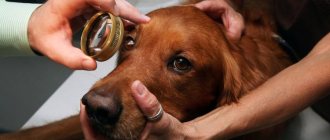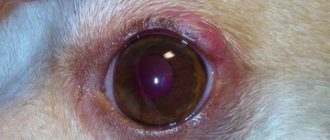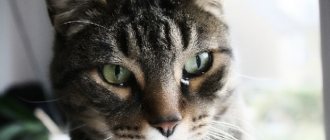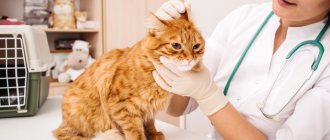Causes of a cloudy film on the eye
When a scar forms on the cornea of the visual organ, a cataract or leukoma appears, which manifests itself as a cloudy spot on one or both of the cat's eyes. This disease is very similar to cataracts, but only in the second case it is not the cornea that suffers, but the lens.
The fundamental cause of the disease is damage to the visual organ due to an ulcer, as well as all types of keratitis (bacterial, ulcerative, viral).
Other reasons include:
- Damages directly to the cornea - due to infectious diseases, mechanical damage, inflammatory process (with allergies and metabolic disorders);
- With swelling of the cornea or accumulation of calcium and cholesterol in it;
- With chlamydial trachoma - when the conjunctiva becomes thicker and a scar forms.
Experts distinguish two types of cataracts: congenital or acquired. According to statistical data, the majority of mustache sufferers suffer from a secondary form of the disease, which is a consequence of other diseases of the visual organ.
If a fluffy baby was born with a cataract, then most likely his mother suffered a viral or bacterial disease during pregnancy.
Depending on the location of the spot, the disease is divided into: central (when the central part of the visual organ is affected), peripheral (when the spot does not affect the pupil) and total (when the entire eye or even both are clouded).
Eye pathologies
The main pathologies of the eye that cause clouding of the lens or cornea. Of these, the following should be highlighted:
Keratitis
or the occurrence of inflammatory processes in the corneal tissues. In this case, the eye becomes cloudy only on the outside, while no dangerous changes occur inside. But why do inflammatory processes occur? Inflammation often occurs due to injury or infection in the visual organ. The described disorders are often the cause of the development of a disease such as keratitis. Any form of this disease causes significant harm to the health of the pet. This can be explained by the fact that the inflammatory process in the cornea in most cases leads to its death.
Glaucoma
With this disease, intraocular pressure increases, as a result of which the organ of visual perception increases in size. At the same time, the ability to see clearly is lost. If such a disease occurs, you can observe poor coordination of movements in the cat and dilated pupils. As for the cornea of the eye, it completely whitens and becomes less sensitive. Due to the sudden loss of vision, the animal runs the risk of bumping into various objects, which can lead to additional damage. The risk of negative consequences increases if the second eye is also infected. Due to such a serious illness, the tissues of the sensory organ harden, and the eye lens dislocates. It is also worth noting that in some cases this pathology is congenital and often occurs in an acute form.
Cataract
As this disease progresses, predominantly the central part of the eye, in the area of the pupil, becomes cloudy. One or both eyes can become infected with cataracts. As the disease progresses, the lens becomes less transparent, almost white. The disease can occur due to infection, as well as as a result of traumatic exposure or an inflammatory process.
Conjunctivitis
It is characterized by copious transparent discharge from the eyes, which in the most severe stages can become purulent. At the same time, the pet’s general health worsens, body temperature rises, redness and swelling of the eye occurs, and the pupil area often becomes cloudy. If eye pathologies occur, you must immediately contact a veterinarian with many years of experience. Based on the tests, it will help to correctly determine the severity of the disease and prescribe the necessary treatment to prevent negative consequences.
You may be interested in: Symptoms of cystitis in a cat: treatment and prevention
Symptoms
Leukoma signals itself through visible changes in the visual organ and changes in the pet’s behavior:
- the fluffy hides away from the light and develops lacrimation;
- purulent discharge and nodules may appear;
- if the keratitis is vascular, the eye becomes cloudy and a reddish tint appears on the affected area;
- if the keratitis is purulent, then the cloudiness turns yellow;
- with an ulcerative lesion, the upper part of the cornea will be unevenly painted, and its surface will acquire a bumpy texture;
- if a fluffy has a problem due to intracranial pressure, then the thorn seems to stick out;
- if the pupil is injured, then in the process of scarring its contour changes;
It is very important to identify the disease at an early stage, immediately after damage or when there is visible redness. If the thorn degenerates into adipose tissue, then this causes complete atrophy of the visual organ. In addition, leukoma causes considerable discomfort to the pet, because its presence reduces visual acuity, especially if the film is located directly on the pupil.
Therapy
So, is it possible to cure a cat's eyesore? Sometimes they use traditional methods (although we still do not recommend doing this). Honey showed good results. More precisely, its aqueous solution. If you put a few drops a day into the affected eye, there is some chance of success. But treatment with folk remedies will not help you if the cat has some kind of dangerous infectious disease, and you will not cure intraocular pressure this way.
It is safer to seek help from scientific methods. The eyes are washed with Metrogyl and Gamavit is administered parenterally. In many cases, tetracycline ointment or Actovegin-based products will not hurt. But it's not always that simple. If a cataract appears as a consequence or a precursor of glaucoma, then the eyeball sometimes has to be completely removed.
Novocaine blockades have worked well. Sometimes a cataract can develop due to the herpes virus. In this case, treatment is more complicated and involves long-term use of antiviral drugs.
Diagnostics
If your pet is diagnosed with leukoma, the most correct decision would be to take it to a veterinary clinic, where a specialist will first determine the root of the problem. The veterinarian will work according to the following scheme:
- Examine the fluffy's fundus. Using a slit lamp, he will analyze the structure of the conjunctiva, as well as the condition of the lens, cornea and iris;
- Conduct a fluorescein test - an effective method that excludes or confirms damage to the epithelial layer of the visual organ. If the cause of the problem is mechanical damage or ulceration, then this is the most effective stage of diagnosis;
- Perform a Seidel test, which is necessary to identify penetrating damage to the cornea or fistulas;
- Perform tonometry (to determine intraocular pressure) and gonioscopy (to examine the anterior part of the visual organ);
- If there is a suspicion of viral diseases (hepatitis, immunodeficiency virus or plague), the specialist will prescribe a referral for diagnostic tests;
- If there is a separation from the visual organ, he will take smears to analyze the flora;
- Perhaps he will give you a referral for an eye ultrasound.
How to help your pet?
Effective therapy is prescribed by a doctor after identifying the causes of the disease. It is very important not to delay visiting the clinic while the disease is at the inflammatory stage and scar tissue has begun to form.
- If keratitis is detected, the fluffy must be treated with drops or ointments (tetracycline or fluxal). The course is at least 14 days.
- To speed up the process of corneal restoration, keratoprotectors are used, which are placed in the cat's eyes 3 times during the day. Course – 14 days.
- If a cat has a spot on its eye due to injury, then the visual organ should be immediately rinsed. solution or miramistin, and then use tetracycline drops.
- In case of severe pain, in order to alleviate the condition of the mustache, a specialist injects a solution of novocaine in combination with hydrocortisone under the eyeball.
- In case of increased pressure inside the visual organ, pilocarpine or brinzolamide will most likely be prescribed.
- The cataract itself is removed through surgery, but only after the inflammation has subsided.
For the therapy to fulfill its purpose, follow all the veterinarian’s instructions. Also, provide the mustache with rest and monitor the condition of the eyes (if it worsens, consult a doctor). If your furbaby is constantly rubbing his eyes, you should put a veterinary collar on him.
Treatment
First of all, it is worth noting that everything depends on the nature of the identified disease. In some cases, surgery may be required.
You need to remember the following:
- If the cloudy eye appears as a result of an infectious disease, then the pet will need treatment with antibiotics that have a wide spectrum of action. Antibacterial agents can also help, and their dosage should be much higher. Only an experienced veterinarian can give accurate recommendations;
- If there are corneal ulcers or glaucoma develops, then surgical intervention will be required. Therefore, you should not delay treatment with medications. This is explained by the fact that in the case of surgery, complete removal of the eye may be required (in case of developing glaucoma). Corneal ulcers are eliminated less problematically, and only damaged tissue is excised. You should be prepared for the fact that after surgery, scars often remain, which makes it almost impossible to fully restore vision. However, the pet will still be able to see and distinguish objects;
- In some cases, the veterinarian may prescribe non-steroidal anti-inflammatory drugs. They should be used only as prescribed by a doctor, since such medications have a number of contraindications. Over a long period of use, they can even have a negative effect on the animal’s body;
- For almost any type of disease, the veterinarian will prescribe antiseptic eye drops, which should be applied to the conjunctival cavity. You can also add various ointments (tetracycline, gamavit, etc.). This will help moisturize the damaged organ and protect against the penetration of various microbes into the eye, which will prevent the occurrence of pathogenic microflora;
- Metrogyl solution can have an effective effect. They should rinse the cat's eye to relieve symptoms of diseases;
- The use of medications based on Actovegin;
- Use of antiviral drugs. In addition to medications and procedures, you should also provide your pet with comfortable living conditions. The animal requires complete rest and a special diet (food must contain vitamins A and E). Vitamins will allow you to restore damaged areas of the eye in a shorter period and even restore vision. However, pet treatment must be comprehensive. Otherwise, when using any one method, it is unlikely that it will be possible to see an improvement in the animal’s condition.
You might be interested in: A cat scratching its butt on the carpet: worms, inflammation or irritation?
Preventive measures
It is easier to prevent any illness than to treat it later. Therefore, if the visual organ is injured, the mustache should be immediately taken to the hospital for examination.
At the same time, do not forget about scheduled vaccinations and regular preventive examinations of your pet.
Plan your cat's menu - it should include all the necessary macro and microelements, as well as vitamins. Protect your purr as much as possible from all kinds of chemicals and toxic substances.
If you suspect a disease of the visual organ, you should not use medications without first consulting a specialist. Also, do not use drugs intended for humans.











